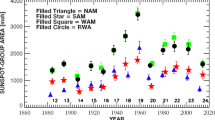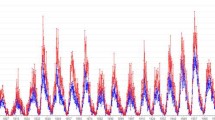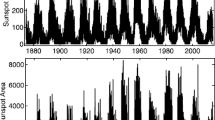Abstract
The use of spotless days to predict future solar activity is revised here based on the new version of the sunspot number index with a 24-month filter. Data from Solar Cycle (SC) 10 are considered because the temporal coverage of the records is 100% for this solar cycle. The interrelationships of the timing characteristics of spotless days and their comparison with sunspot cycle parameters are explored; in some cases, we find very strong correlations. Such is the case for the relationship between the minimum time between spotless days either side of a given solar maximum and the maximum time between spotless days either side of the previous solar minimum, with \(r = -0.91\) and a \(p\mbox{-value} < 0.001\). However, the predictions for SCs 24 or 23 made by other authors in previous works using spotless days as a predictor of solar activity are not correct since the predictions have not been fulfilled. Although there seems to be a pattern of strong correlation for some relationships between the parameters that have been studied, a prediction of future solar cycles from these parameters defined as functions of spotless days should be made with caution because the estimated values are sometimes far from the observed ones. Furthermore, SC 23 seems to show a mode change, a break with respect to the behaviour of previous solar cycles and more similar to SCs 10 – 15.












Similar content being viewed by others
References
Carrasco, V.M.S., Aparicio, A.J.P., Vaquero, J.M., Gallego, M.C.: 2016, The new sunspot-number index and solar-cycle characteristics. Solar Phys. 291, 3045. DOI .
Charbonneau, P.: 2010, Dynamo models of the solar cycle. Living Rev. Solar Phys. 7, 3. DOI .
Clette, F., Berghmans, D., Vanlommel, P., Van der Linden, R.A.M., Koeckelenbergh, A., Wauters, L.: 2007, From the Wolf number to the international sunspot index: 25 years of SIDC. Adv. Space Res. 40, 919. DOI .
Clette, F., Svalgaard, L., Vaquero, J.M., Cliver, E.W.: 2014, Revisiting the sunspot number. A 400-year perspective on the solar cycle. Space Sci. Rev. 186, 35. DOI .
Clette, F., Cliver, E.W., Lefèvre, L., Svalgaard, L., Vaquero, J.M.: 2015, Revision of the sunspot number(s). Space Weather 13, 529. DOI .
Clette, F., Cliver, E.W., Lefèvre, L., Svalgaard, L., Vaquero, J.M., Leibacher, J.W.: 2016, Preface to topical issue: Recalibration of the sunspot number. Solar Phys. 291, 2479. DOI .
Cranmer, S.R., Hoeksema, J.T., Kohl, J.L.: 2010, SOHO-23: Understanding a Peculiar Solar Minimum, ASP Conference Series. Astronomical Society of the Pacific, San Francisco.
Du, Z., Du, S.: 2006, The relationship between the amplitude and descending time of a solar activity cycle. Solar Phys. 238, 431. DOI .
Haigh, J.D.: 2007, The Sun and the Earth’s climate. Living Rev. Solar Phys. 4, 2. DOI .
Hathaway, D.H.: 2015, The solar cycle. Living Rev. Solar Phys. 12, 4. DOI .
Hoyt, D.V., Schatten, K.H.: 1998, Group sunspot numbers: A new solar activity reconstruction. Solar Phys. 179, 189. DOI .
Kane, R.P.: 2008, How useful is the Waldmeier effect for prediction of a sunspot cycle? J. Atmos. Solar-Terr. Phys. 70, 1533. DOI .
Pesnell, W.D.: 2012, Solar cycle predictions. Solar Phys. 281, 507. DOI .
Petrovay, K.: 2010, Solar cycle prediction. Living Rev. Solar Phys. 7, 6. DOI .
Pulkkinen, T.: 2007, Space weather: Terrestrial perspective. Living Rev. Solar Phys. 4, 1. DOI .
Solanki, S.K., Krivova, N.A., Schüssler, M., Fligge, M.: 2002, Search for a relationship between solar cycle amplitude and length. Astron. Astrophys. 396, 1029. DOI .
Svalgaard, L., Schatten, K.H.: 2016, Reconstruction of the sunspot group number: The Backbone method. Solar Phys. 291, 2653. DOI .
Usoskin, I.G., Kovaltsov, G.A., Lockwood, M., Mursula, K., Owens, M., Solanki, S.K.: 2016, A new calibrated sunspot group series since 1749: Statistics of active day fractions. Solar Phys. 291, 2685. DOI .
Vaquero, J.M.: 2007, Historical sunspot observations: A review. Adv. Space Res. 40, 929. DOI .
Vaquero, J.M., Vázquez, M.: 2009, The Sun Recorded Through History, Springer, Berlin. DOI .
Vaquero, J.M., Svalgaard, L., Carrasco, V.M.S., Clette, F., Lefèvre, L., Gallego, M.C., Arlt, R., Aparicio, A.J.P., Richard, J.-G., Howe, R.: 2016, A revised collection of sunspot group numbers. Solar Phys. 291, 3061. DOI .
Wilson, R.M.: 1995, On the use of ‘first spotless day’ as a predictor for sunspot minimum. Solar Phys. 158, 197. DOI .
Wilson, R.M., Hathaway, D.H.: 2005, On the relation between spotless days and the sunspot cycle. Technical Report, NASA/TP-2005-213608.
Wilson, R.M., Hathaway, D.H.: 2006, On the relationship between spotless days and the sunspot cycle: A supplement. Technical Report, NASA/TP-2006-214601.
Acknowledgements
This research was supported by the Economy and Infrastructure Counselling of the Junta of Extremadura through project IB16127 and grant GR15137 (co-financed by the European Regional Development Fund) and by the Ministerio de Economía y Competitividad of the Spanish Government (AYA2014-57556-P).
Author information
Authors and Affiliations
Corresponding author
Ethics declarations
Disclosure of Potential Conflicts of Interest
The authors declare that they have no conflicts of interest.
Rights and permissions
About this article
Cite this article
Carrasco, V.M.S., Vaquero, J.M. & Gallego, M.C. Analysing Spotless Days as Predictors of Solar Activity from the New Sunspot Number. Sol Phys 292, 154 (2017). https://doi.org/10.1007/s11207-017-1172-6
Received:
Accepted:
Published:
DOI: https://doi.org/10.1007/s11207-017-1172-6




